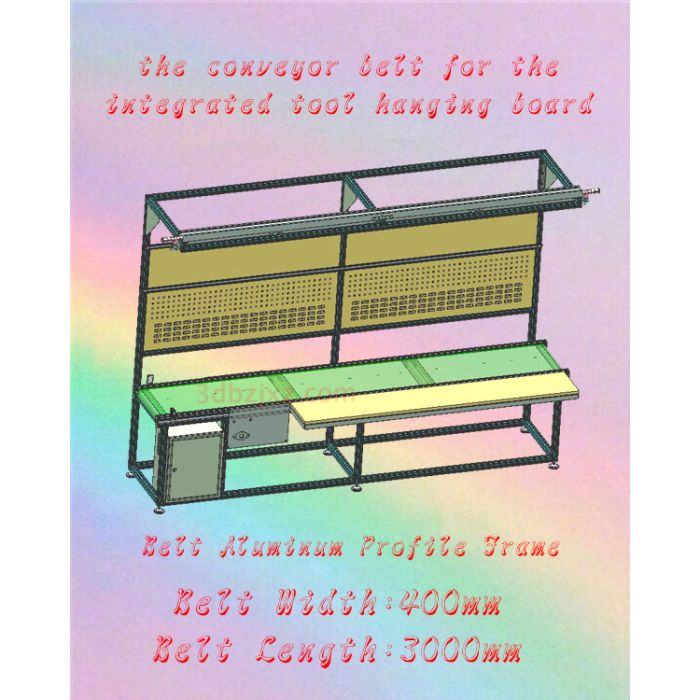beltconveyor_w400_l3000
- Stp samples download
- click to down
试用数据点击上方下载!
The height of the conveyor belt for the integrated tool hanging board is a problem that needs to be considered comprehensively based on multiple factors. The following are the key steps and considerations for determining its height:
1、 Key steps
Clear requirements:
Determine the type, size, and weight of the tool hanging plate that needs to be mounted on the conveyor belt.
Understand the mounting method of the tool hanging board on the conveyor belt, whether it is vertically suspended or horizontally placed.
Collect information:
Obtain the type, material, load-bearing capacity, and design parameters of the conveyor belt.
Understand the special requirements of the production line or working environment where the conveyor belt is located, such as space restrictions, safety regulations, etc.
Perform calculations:
Based on the size and weight of the tool hanging board, as well as the carrying capacity of the conveyor belt, the height range of the conveyor belt is preliminarily determined.
Considering the stability and safety of the tool hanging board on the conveyor belt, adjust the height to ensure that it will not fall off or be damaged due to shaking or tilting.
Verification and adjustment:
Verify whether the height of the conveyor belt meets the requirements through actual testing or simulated operation.
Make necessary adjustments based on the test results to ensure that the height of the conveyor belt meets both production requirements and safety.
2、 Consider factors
Equipment design:
The structural design, material selection, and manufacturing process of conveyor belts all have an impact on their height.
It is necessary to consider the design of components such as the support and drum of the conveyor belt to ensure that the height of the conveyor belt meets the requirements of stability and load-bearing capacity.
Usage environment:
The production line or working environment where the conveyor belt is located may have height restrictions.
Space limitations, safety regulations, and potential obstacles need to be considered to ensure that the height of the conveyor belt does not pose safety hazards or affect production efficiency.
Material characteristics:
Although the material mainly refers to the tool hanging board in this scenario, its weight, size, and shape still have an impact on the height of the conveyor belt.
It is necessary to ensure that the height of the conveyor belt can accommodate and stably transport the tool hanging board, while avoiding damage or accidents caused by improper height.
Safety and stability:
The height of the conveyor belt needs to ensure the stability and safety of the tool hanging board during the conveying process.
It is necessary to consider safety measures such as preventing tool hanging boards from falling off, tilting, or colliding to ensure the smooth progress of the production process.
Maintenance and operation:
The height of the conveyor belt also needs to consider the convenience of maintenance and operation.
It is necessary to ensure that operators can easily access the conveyor belt for maintenance and inspection, while avoiding operational difficulties or safety hazards caused by improper height.
In summary, determining the height of the conveyor belt for the integrated tool hanging board requires comprehensive consideration of multiple factors, including equipment design, usage environment, material characteristics, safety and stability, as well as maintenance and operation. By clarifying requirements, collecting information, conducting calculations, and verifying adjustments, it is possible to ensure that the height of the conveyor belt meets both production needs and safety.
集成工具挂板的输送带高度是一个需要根据多种因素综合考虑的问题,以下是确定其高度的关键步骤和考虑因素:
一、关键步骤
-
明确需求:
- 确定输送带上需要挂载的工具挂板的类型、尺寸和重量。
- 了解工具挂板在输送带上的挂载方式,是垂直悬挂还是水平放置。
-
收集信息:
- 获取输送带的类型、材料、承载能力和设计参数。
- 了解输送带所在的生产线或工作环境的特殊要求,如空间限制、安全规定等。
-
进行计算:
- 根据工具挂板的尺寸和重量,以及输送带的承载能力,初步确定输送带的高度范围。
- 考虑工具挂板在输送带上的稳定性和安全性,调整高度以确保不会因晃动或倾斜而导致脱落或损坏。
-
验证和调整:
- 通过实际测试或模拟运行来验证输送带高度是否满足要求。
- 根据测试结果进行必要的调整,以确保输送带高度既符合生产需求又保证安全。
二、考虑因素
-
设备设计:
- 输送带的结构设计、材料选择以及制造工艺等都会对其高度产生影响。
- 需要考虑输送带的支架、滚筒等部件的设计,以确保输送带的高度满足稳定性和承载能力的要求。
-
使用环境:
- 输送带所在的生产线或工作环境可能对高度有限制。
- 需要考虑空间限制、安全规定以及可能存在的障碍物,以确保输送带高度不会造成安全隐患或影响生产效率。
-
物料特性:
- 虽然在此场景中物料主要指的是工具挂板,但其重量、尺寸和形状仍会对输送带的高度产生影响。
- 需要确保输送带高度能够容纳并稳定地输送工具挂板,同时避免因高度不当而导致的损坏或事故。
-
安全性和稳定性:
- 输送带高度需要确保工具挂板在输送过程中的稳定性和安全性。
- 需要考虑防止工具挂板脱落、倾斜或碰撞等安全措施,以确保生产过程的顺利进行。
-
维护和操作:
- 输送带高度还需要考虑维护和操作的便利性。
- 需要确保操作人员能够方便地接近输送带进行维护和检查,同时避免因高度不当而导致的操作困难或安全隐患。
综上所述,确定集成工具挂板的输送带高度需要综合考虑多种因素,包括设备设计、使用环境、物料特性、安全性和稳定性以及维护和操作等。通过明确需求、收集信息、进行计算和验证调整等步骤,可以确保输送带高度既符合生产需求又保证安全。

